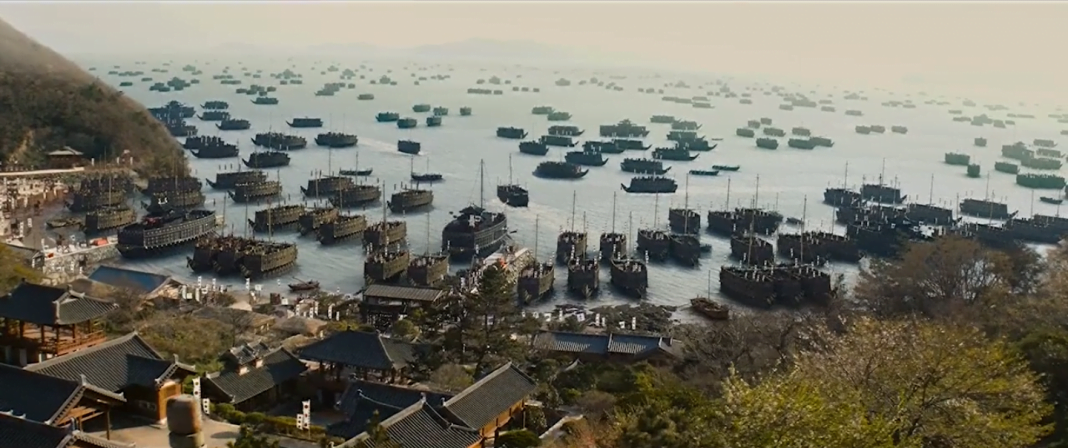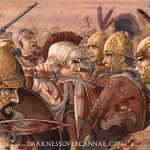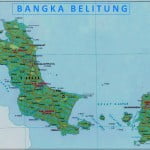The Battle of Myeongnyang. This represents the greatest “victory against all odds” -type battle I have ever seen. This battle occurred in 1597 AD and involved Admiral Yi Sun-shin of the Korean navy (with 13 warships, which he had designed himself) against the 130+ warships of the Japanese name. That’s a disparity of literally 10-to-one. In addition, the Japanese had 200 support ships in the wings.
Anyway, the Japanese were obviously quite eager to engage in battle, as it would be almost impossible for them to lose. Or so they thought.
In the morning of October 26, they sent forth their 130+ ships, sat back, and waited for the inevitable. Admiral Yi Sun-shin was at such a severe disadvantage, it would take a miracle for him to win. In fact, 12 of the 13 warships didn’t even participate in the first half of the battle because they thought it would be suicide. Only Yi Sun-shin’s personal battleship was fighting during that period.
Yi Sun-shin, however, was a master tactician. He withdrew to the area designated above (below Myeongyang Strait) and hugged the hillside, causing his ship to be cloaked in shadow. He then proceeded to make use his incredibly mobile warship to engage the enemy in devastating salvos without suffering too much damage himself. At about halfway through the battle, the rest of his ships (except for one) joined him and proceeded to keep the majority of the Japanese fleet bottlenecked in the Myeongyang Strait (the underwater steel wire which Yi Sun-shin had placed beforehand also helped). This heavily reduced the numerical advantage of the Japanese forces. As more and more Japanese warships crammed into the strait, the sea around it became more and more crowded. However, the small Korean fleet could not press forwards and deal its maximum potential damage, mainly because the Japanese fleet was still well-ordered, merely tightly pressed. It was then that Admiral Yi Sun-shin revealed his trump card.
As the battle neared its climax, the tide began to shift and flow in the opposite direction. Yi Sun-shin had masterfully chosen the battle site and the time of battle in order to utilize a unique natural phenomenon around the strait. The Japanese fleet, unprepared, suffered catastrophic consequences. Their warships began to shift and collide with each other, causing massive damage and confusion. In that critical moment, Admiral Yi Sun-shin struck. His fleet charged forward and made use of the confusion to rain arrows and cannon fire upon the enemy fleet. Many warships were damaged, and vast hordes of Japanese sailors leapt off of their ships and swam for shore. However, Yi Sun-shin had picked the area for another reason — those sailors who weren’t picked off by cannonfire or arrows drowned in the incredibly strong currents of the strait, as well as the isolated eddies and whirlpools scattered about the surrounding sea.
In the end, the Japanese commanders made the tactical decision to retreat, and they only lost around 30 ships of their fleet. However, many more were damaged or crippled by enemy fire, and, as I mentioned previously, they lost huge amounts of sailors, rendering their fleet severely handicapped.
Yi Sun-shin and the Korean forces lost only two men, and not a single one of their ships were either destroyed or severely damaged.
In regard this as being an extremely epic battle because Admiral Yi-Sun shin won against vastly numerically superior forces without losing a single ship, and if he had lost, the Japanese would have had undisputed control of the seas around Korea, gaining Japan their operational foothold to commence the conquest of China.
(P.S. Yi Sun-shin fought more than twenty other battles in that war, including the battle of Hansan Island (in which the Korean admiral defeated 66 out of 133 enemy warships without losing a single warship) and the battle of Okpo (in which Admiral Yi Sun-shin used a force of 45 warships to defeat an enemy force numbering 70 warships without losing a single man.)
I would also list the battles of Thermopylae, Trafalgar, and Salamis among epic battles in history with huge consequences.



